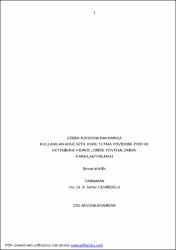| dc.contributor.advisor | Cevrioğlu, Arif Serhan | |
| dc.contributor.author | Şahin, Binaz | |
| dc.date.accessioned | 2015-04-21T13:04:44Z | |
| dc.date.available | 2015-04-21T13:04:44Z | |
| dc.date.issued | 2005 | |
| dc.date.submitted | 2005 | |
| dc.identifier.uri | http://hdl.handle.net/11630/3939 | |
| dc.description.abstract | Araştırmada, ülkemizde göbek kordonu bakım yöntemlerinde yaygın olarak
kullanılmakta olan Povidon iyod ile, bu konuda güncel tartışma konusu olan diğer
yöntemlerin (anne sütü, kuru tutma ve Oktenidine hidrokloride) göbek kordonunun
düşme hızı, bakteri kolonizasyonu ve omfalit gelişme riskine olan etkileri yönüyle
karşılaştırılması planlandı.
Bu araştırma, Afyon Kocatepe Üniversitesi (A.K.Ü.) Uygulama ve Araştırma
Hastanesi Doğum ve Kadın Hastalıkları AB servisinde yapılmıştır.
Kasım 2003- Eylül 2004 tarihleri arasında toplanan verilere, Bilgisayar
İstatistik Programı (S.P.S.S.) ile önemlilik testleri uygulanmıştır.
Yenidoğan bebeklerin göbek kordon bakımında bir gruba kuru tutma (n=22),
diğer üç grubun bakımında ise anne sütü (n=22), Povidon-iyod (n=22) ve Octenidine
hidrocloride (n=23) kullanılmıştır. Povidon-iyod kullanılan grupta göbek kordonu
düşme süresinin diğer gruplara göre uzun olduğu, göbek bakımında kuru tutma
yöntemi uygulanan grupta daha kısa olduğu görülmüştür (p<0,001).
Çalışmada yalnızca 4 vakada omfalit kliniğinin geliştiği saptanmıştır. Bunların
ikisi anne sütü, ikisi kuru tutma yöntemi uygulanan yenidoğanlarda gözlenmiştir.
Omfalit gelişimi açısından gruplar arasındaki fark istatistiksel olarak anlamsız
bulunmuştur (p>0,05).
Çalışmada 18 vakada bakteri kolonizasyonu saptanmıştır. Bu etkenlerden 7
tanesinin Escherichia coli (E. coli), 10 tanesinin Staphylococcus aureus (S. aureus)
ve 1 tanesininde Klebsiella olduğu tespit edilmiştir. Bu vakaların 13 tanesinin anne
sütü grubunda, 3 tanesinin Povidone-iyod grubunda ve 2 tanesinin Octenidine
hidrocloride grubunda olduğu saptanmıştır. Bakteri kolonizasyonu açısından gruplar
arasındaki fark istatistiksel olarak anlamlı bulunmuştur (p<0,001).
Araştırmamızda olgu sayımızın (n=89) az olması verilerimizin istatistiksel gücünü
sınırlamakla beraber, kuru tutma yönteminin etkili ve pratik bir yöntem olduğunu
söyleyebiliriz. | en_US |
| dc.description.abstract | In this investigation we planned to compare novel methods of umbilical cord care
(breast milk, keeping dry and Octenidine hydrocloride) with the Povidone-iodine
which is used commonly in our country in terms of cord separation time, bacterial
colonization and omphalitis occurence risk.
This investigation was conducted at Afyon Kocatepe University, Education
and Research Hospital, Department Obstetrics and Gynecology. Significance tests
were applied to the datas obtained between November 2003 – September 2004.
To take care of umbilical cord, one group was subjected to method of keeping
dry (n=22) and the other groups were subjected to methods respectively; breast milk
(n=22), Povidone iodine (n=22), and Octenidine hydrochloride (n=23). The duration
of umbilical cord fall off was longer in the Povidone-iodine group compared to
others and the same duration was shorter in the keeping dry group (p<0,001).
In the study, only in 4 cases, omphalitis was determined. Two of these cases
were belonging to the group of keeping dry and the other two were of breast milk
group. The difference between the groups in terms of omphalitis was determined to
be insignificant (p>0,05).
We determined bacterial colonization in18 cases in the study. The causes of
these infections were; E. coli infections in 7 cases, S. aureus infections in 10 cases,
and Klebsiella in 1 case. The distribution of these cases in terms of applied methods
were as follows: 13 of them were in the breast milk group, 3 of them were in the
Povidone-iodine group, and 2 of them were in the Octenidine hydrochloride group.
The difference between the groups in terms of bacterial colonization was found to be
statistically significant (p<0,001).
Despite the low number of our cases limits the statistical power of the study,
we can coclude that keeping dry is an effective and practical method in umbilical
cord care. | en_US |
| dc.language.iso | tur | en_US |
| dc.publisher | Afyon Kocatepe Üniversitesi, Sağlık Bilimleri Enstitüsü | en_US |
| dc.rights | info:eu-repo/semantics/openAccess | en_US |
| dc.subject | Göbek Kordonu Bakımı | en_US |
| dc.subject | Povidon İyod | en_US |
| dc.subject | Octenidine Hidrocloride | en_US |
| dc.subject | Anne Sütü | en_US |
| dc.subject | Kuru Tutma | en_US |
| dc.title | Göbek Kordonu Bakımında Kullanılan Anne Sütü, Kuru Tutma, Povidoniyod ve Octenidine hidrocloride Yöntemlerinin Karşılaştırılması | en_US |
| dc.title.alternative | The Comparison of Methods Employed in Umbilical Cord Care; Breast Milk, Keeping Dry, Povidone İodine and Octenidine Hydrochloride | en_US |
| dc.type | masterThesis | en_US |
| dc.department | Afyon Kocatepe Üniversitesi, Sağlık Bilimleri Enstitüsü, Hemşirelik Bölümü | en_US |
| dc.relation.publicationcategory | Tez | en_US |



















